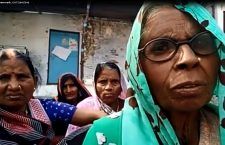Every morning, children in Chiraigaon in Varanasi don their red and grey school uniforms and head to Barthakalon Secondary School—to sweep, mop and wash it.
“Our school is dirty,” said student Kajal Maurya, “So we just clean up whenever we want to sit, we sweep our classrooms, and when we’re done playing outside, we clean the grounds with some water.” Her peer Reshma Kanaujiya makes note of another task they need to do: “There is no dustbin in school right now. So we all collect the waste, get it together in one place and burn it.” She added casually, “We make sure to douse the fire later.”
These students of Classes 9 and 10—the ostensible future of their families, communities and the country—spending time everyday to clean the premises of their school, seem to be a long way off from some of the affirmative findings highlighted in the recently released ASER report, a comprehensive study of the state of rural education in India.
The students of Barthakalon Secondary School have been following this routine for months on end, we learn.When asked why, Kanaujiya simply said, “Because the cleaner doesn’t come here. And the dai only cooks.”
When the Right to Education Act was brought into place in 2009, it was recognized as a step forward in education. With norms laid down for pupil-teacher ratios, infrastructure and number of working days, it attempted to formalize the education system and afford the children of this country quality education. But the large concerns around the focus that is primarily on enrollment numbers and infrastructure standards, instead of quality education, have remained.
Zoning in on Uttar Pradesh specifically, while the state may be able to brag about the fact that 99.1% of all secondary and higher secondary schools in 2015-2016 had a building or that 94.82% had a boundary wall—the events unfolding within those walls are questionable, to say the least.
Satendra Kumar nods in assent when asked whether the uncleanliness of the school has been bad for students’ health, “We cover our faces with a handkerchief when we’re cleaning and”—he laughed suddenly—“if we have a cold, we blow our noses into it as well.” He added matter of factly, “Madam, there is a lot of dirt here.”
Sudha Kumari, the school in-charge, reiterated what Kanaujiya said, “The cleaner doesn’t come here. He hasn’t come since July [2018].” When asked what has been done about it, she said, “We took our complaint to the principal, to the secretary, to the block—but nobody is listening to us.” Her complaint, she claimed, had been filed in August/September 2018. Kumariadded that the daialso cleans the grounds – a claim vehemently denied bythe students.
The village pradhan, Kalavatiwas not willing to speak about the issue, but her husband, Rajendra Sinha, readily represented her,prepared for the questions coming his way. “We have filed an application asking for three cleaners for the school,” he said in a decisive tone,and elaborated, “This is an old problem. When I joined this school in 2016, we saw that the number of cleaners coming to work had started to fall until there was no one left. We filed an application right then.” Sinha was of the opinion however that the problem had been dealt with, “Only after filing this application did we finally get one cleaner.”
By the time we got an audience with the Additional Development Officer (ADO) of the Panchayat Ravindra Sinha, the problem had been solved, “I think all the cleaners here are working diligently.”
We met the singular assigned cleaner, Gulelan Prasad, who immediately went on the offensive, “I go everyday to clean the school.” When asked why the children have been cleaning then, he back-pedalled, “I have been busy with other work in the last couple of days. That’s why I haven’t gone to the school recently.” When our reporter questioned the degree of uncleanliness she saw, he replied, miffed, “There are three schools under me. Plus I have to do the village rounds.”
Until there is some accountability for the existing situation, the students at Barthakalon Secondary School it seems will keep coming to their filthy school, a pen in one hand and a broom in the other.
This Khabar Lahariya article first appeared on Firstpost.

